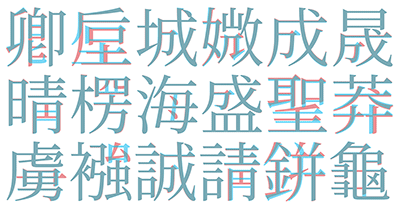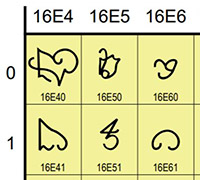 The Unicode Consortium is pleased to announce the release of the 2017-12-12 version of the Unicode Ideographic Variation Database (IVD), which is the sixth version, and includes five registered collections. This version registers the new KRName collection and the first 36 sequences in that collection, four additional sequences in the registered Adobe-Japan1 collection, and 674 additional sequences in the registered Moji_Joho collection. Details can be found on the main IVD page.
The Unicode Consortium is pleased to announce the release of the 2017-12-12 version of the Unicode Ideographic Variation Database (IVD), which is the sixth version, and includes five registered collections. This version registers the new KRName collection and the first 36 sequences in that collection, four additional sequences in the registered Adobe-Japan1 collection, and 674 additional sequences in the registered Moji_Joho collection. Details can be found on the main IVD page.
Tuesday, December 12, 2017
New version of Unicode Ideographic Variation Database released
 The Unicode Consortium is pleased to announce the release of the 2017-12-12 version of the Unicode Ideographic Variation Database (IVD), which is the sixth version, and includes five registered collections. This version registers the new KRName collection and the first 36 sequences in that collection, four additional sequences in the registered Adobe-Japan1 collection, and 674 additional sequences in the registered Moji_Joho collection. Details can be found on the main IVD page.
The Unicode Consortium is pleased to announce the release of the 2017-12-12 version of the Unicode Ideographic Variation Database (IVD), which is the sixth version, and includes five registered collections. This version registers the new KRName collection and the first 36 sequences in that collection, four additional sequences in the registered Adobe-Japan1 collection, and 674 additional sequences in the registered Moji_Joho collection. Details can be found on the main IVD page.
Monday, December 11, 2017
Feedback on Draft additional repertoire for ISO/IEC 10646:2017 (5th edition) DAM1 and PDAM2.2
 The Unicode Technical Committee is soliciting feedback on pending additions
to the draft repertoire of characters, to help discover any errors in character
names, incorrect glyphs, or other problems. There is a short window of
opportunity to review and comment on the repertoire additions noted below.
The Unicode Technical Committee is soliciting feedback on pending additions
to the draft repertoire of characters, to help discover any errors in character
names, incorrect glyphs, or other problems. There is a short window of
opportunity to review and comment on the repertoire additions noted below.The following additional repertoires from ISO/IEC 10646:2017 (5th Edition), which are in ballot, and are under review. See the associated repertoires in: Draft additional repertoire for ISO/IEC 10646:2017 (5th edition) DAM1 [PRI #366] and PDAM 2.2 [PRI #365].
The Unicode Standard is developed in synchrony with ISO/IEC 10646. Note that for DAM1, no further changes or corrections will be possible after ISO balloting is completed. Comments the PDAM 2.2 repertoire can be made on later ballots. (See the FAQ Standards Developing Organizations for additional information on the stages in ISO standards development.) Advance feedback on these repertoire additions will help inform the UTC discussions about its own contribution to the ISO balloting process.
Documents referenced in the draft repertoire with numbers such as L2/17-372 (DAM1) and L2/17-366 (PDAM 2.2) are available in the UTC Document Registry.
For information about how to discuss these Public Review Issues and how to supply formal feedback, please see the feedback and discussion instructions.
Wednesday, December 6, 2017
Support Unicode with an Adopt-a-Character Gift this Holiday Season!
 This holiday season you can give a unique gift by adopting any emoji,
letter, or symbol — and help support the Unicode Consortium’s mission to
enable all languages to be used on computers. Three levels of sponsorship
are available, starting at $100. With over 130,000 characters to choose
from, you are certain to find an appropriate character, for even the most
demanding recipient. All sponsors will receive a custom digital badge
featuring the adopted character for use on the web and elsewhere. Sponsors
at the two highest levels will receive a special thank-you gift engraved
with the name you supply and the adopted character.
This holiday season you can give a unique gift by adopting any emoji,
letter, or symbol — and help support the Unicode Consortium’s mission to
enable all languages to be used on computers. Three levels of sponsorship
are available, starting at $100. With over 130,000 characters to choose
from, you are certain to find an appropriate character, for even the most
demanding recipient. All sponsors will receive a custom digital badge
featuring the adopted character for use on the web and elsewhere. Sponsors
at the two highest levels will receive a special thank-you gift engraved
with the name you supply and the adopted character.The program funds work on “digitally disadvantaged” languages, both modern and historic. In 2017 the program awarded grants to support work on Mayan hieroglyphs and historic Indic scripts, among others.
To date, the Adopt-a-Character program has had over 500 sponsors. Be part of the next wave, with a worthwhile gift!
For more information on the program, or to adopt a character, see the Adopt-a-Character Page.
Monday, December 4, 2017
Unicode Emoji 11.0 Beta
Emoji 11.0 beta is now available for developers, with 130 Draft Candidates, such as:







The list is not final: changes can include removals or additions: for example, new ZWJ sequences could be added. The decisions of the 2017Q4 UTC meeting for emoji have been incorporated into the draft Charts, Specification, and Data, and are now available for testing and feedback. The contents will be finalized in 2018Q1. The following are the expected dates for 2018.
The version number for the next release of Unicode emoji is jumping from the previously-released Emoji 5.0 to Emoji 11.0 (instead of 6.0). This is due to alignment of the emoji versions in 2018 and beyond with the versions of the Unicode Standard.
The draft emoji 11.0β Charts now show the candidates in context: for example, Emoji Ordering, v11.0β shows the sorting of all the emoji, with the candidates highlighted with rounded-rectangles. Feedback on the sort-order, categories, names, and keywords is welcome.
The draft 11.0β Specification has a number of changes, including proposed guidelines for display, handling gender, handling skin tone, and a proposed mechanism for allowing emoji to point either to the right or left.
The draft 11.0β Emoji Data provides property data, which determines how implementations handle the new characters.
The list is not final: changes can include removals or additions: for example, new ZWJ sequences could be added. The decisions of the 2017Q4 UTC meeting for emoji have been incorporated into the draft Charts, Specification, and Data, and are now available for testing and feedback. The contents will be finalized in 2018Q1. The following are the expected dates for 2018.
| Emoji Set | Decision date | Announcement of final list | Market availability |
| Draft Emoji Candidates (2018) | 2018-01 | 2018-03 | 2018H2 |
The version number for the next release of Unicode emoji is jumping from the previously-released Emoji 5.0 to Emoji 11.0 (instead of 6.0). This is due to alignment of the emoji versions in 2018 and beyond with the versions of the Unicode Standard.
The draft emoji 11.0β Charts now show the candidates in context: for example, Emoji Ordering, v11.0β shows the sorting of all the emoji, with the candidates highlighted with rounded-rectangles. Feedback on the sort-order, categories, names, and keywords is welcome.
The draft 11.0β Specification has a number of changes, including proposed guidelines for display, handling gender, handling skin tone, and a proposed mechanism for allowing emoji to point either to the right or left.
The draft 11.0β Emoji Data provides property data, which determines how implementations handle the new characters.
Over 130,000 characters are available for adoption, to
help the Unicode Consortium’s work on digitally disadvantaged languages.
![[fortune cookie badge]](http://www.unicode.org/announcements/ynh-fortune-cookie.png)
![[fortune cookie badge]](http://www.unicode.org/announcements/ynh-fortune-cookie.png)

![[fortune cookie badge]](http://www.unicode.org/announcements/ynh-gift-badge.png)